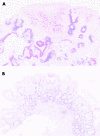Bile reflux gastritis and intestinal metaplasia at the cardia
- PMID: 12171955
- PMCID: PMC1773352
- DOI: 10.1136/gut.51.3.351
Bile reflux gastritis and intestinal metaplasia at the cardia
Abstract
Background and aims: Intestinal metaplasia (IM) at the cardia is likely to be a precursor of cardia cancer. Previous work has shown that it is associated with chronic inflammation attributable to either gastro-oesophageal reflux disease (GORD) or Helicobacter pylori infection. An alternative aetiological factor is bile reflux. Duodenogastric reflux brings about histological changes in the gastric mucosa that can be graded and used to calculate a bile reflux index (BRI). We used the BRI to assess whether reflux of bile plays a part in the development of cardia IM.
Methods: Histological changes in simultaneous gastric antrum and cardia biopsies from 267 dyspeptic patients were independently graded by two pathologists. The association between cardia IM and age, sex, clinical group, H pylori status, increased BRI (>14), and inflammation at the cardia were evaluated using logistic regression.
Results: A total of 226 patients had adequate cardia and antral biopsies; 149 had GORD and 77 had non-ulcer dyspepsia. Cardia IM was present in 66 (29%) patients, of whom 28 (42%) had complete IM. Increasing age, male sex, chronic inflammation, and a high BRI emerged as significant independent associations with cardia IM. Clinical group and H pylori status were not independent risk factors.
Conclusions: Histological evidence of bile reflux into the stomach is associated with cardia IM. This could have an important bearing on carcinogenesis at this site.
Figures

References
-
- Owen DA. Stomach. In: Sternberg SS ed. Histology for pathologists, 2nd edn. Philadelphia: Raven Lippincott, 1997:481.
-
- Fenoglio-Preiser CM, Noffsinger AE, Stemmerman GN, et al. Gastrointestinal pathology. An atlas and text, 2nd edn. Philadelphia: Raven Lippincott, 1999:133.
-
- Chandrasoma PT, Lokuhetty DM, Demeester TR, et al. Definition of histopathologic changes in gastroesophageal reflux disease. Am J Surg Pathol 2000;24:344–51. - PubMed
-
- Carton E, Caldwell MTP, McDonald G, et al. Specialized intestinal metaplasia in patients with gastro-oesophageal reflux disease. Br J Surg 2000;87:116–21. - PubMed
-
- Spechler SJ, Zeroogian JM, Antonioli DA, et al. Prevalence of metaplasia at the gastro-oesophageal junction. Lancet 1994;344:1533–6. - PubMed
Publication types
MeSH terms
LinkOut - more resources
Full Text Sources
Other Literature Sources
